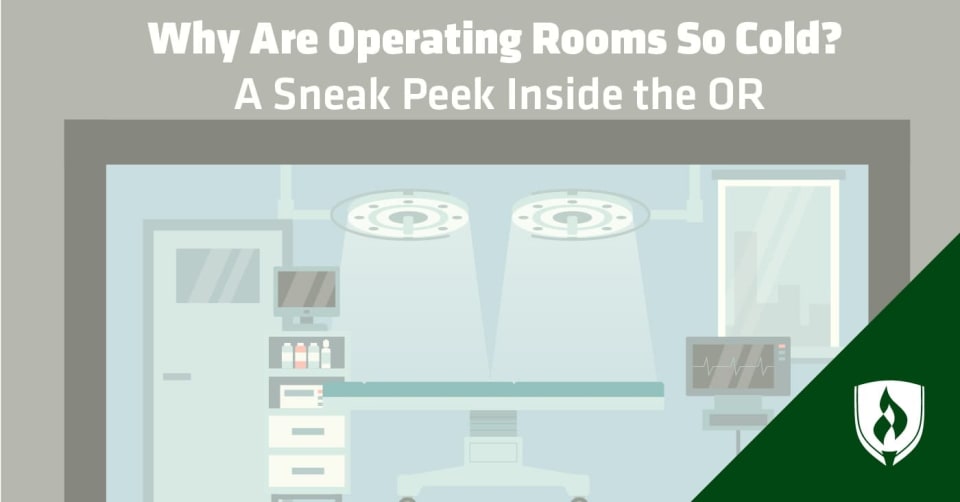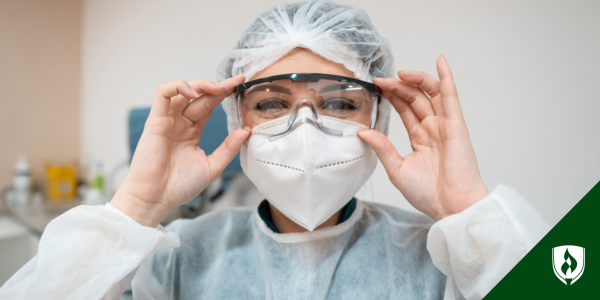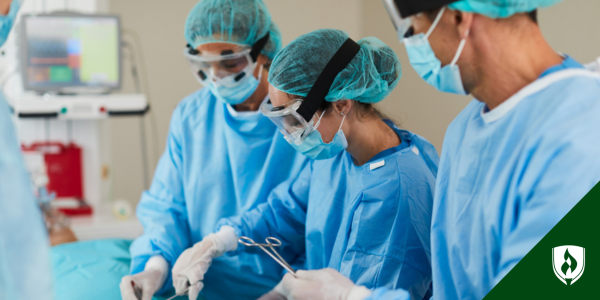
The operating room can be an intriguing place. Patients are typically preoccupied with the effects of sedation, so only a select group of healthcare professionals get to see what goes on in an operating room. While watching shows like Grey’s Anatomy might help cure some of your curiosity, you can’t help but wonder what’s really going on behind the scenes. “Are all operating rooms this cold?” “Do they work in silence?” “What happens if they need a break?”
You’ve got a lot of questions and curiosities you’d like to get to the bottom of—and short of becoming a member of the surgical team, this is your best avenue for finding out. Keep reading for some interesting operating room info.
9 Surgery questions and curiosities you’d like to know more about
We rounded up some common questions and curiosities about what goes on in an operating room and have asked healthcare professionals to give us the inside scoop.
1. Why are operating rooms so cold?
Operating rooms are often described as two things: cold and sterile. While the sterile part of this combo is easy enough to understand, you might be wondering about the temperature. Historically, it was believed that cold temperatures in the OR helped minimize the potential for infections. While that has been disproven, ORs are still kept cool for the comfort of the surgeon and the rest of the surgical team.
The truth is, there’s no one consistent temperature across the board for operating rooms. “The ‘ideal’ temperature varies greatly from surgeon to surgeon,” says Dr. Taylor Graber, resident anesthesiologist and founder of ASAP IVs. He notes that while surgeons and others in sterile OR settings must wear surgical gowns, masks, gloves, hat and eyewear, some surgeons, like orthopedic surgeons, must wear additional heavy lead gowns in surgery to protect them from radiation.
In addition, the bright lights, used to improve visualization, can be very hot themselves. Surgeons and other surgical team members are often right underneath the lights for the entire operation. For surgeries where the lights can be off, and surgeons don’t need to wear the lead gowns, the room does not have to be as cool.
Though the room is kept cool for the comfort of the surgical team, many steps are taken to ensure that the patient does not get too cold during the procedure. This may include warmed air gowns, heating pads and warmed fluids.
2. Are patients restrained during surgery?
Most surgical procedures require anesthesia for the patient. In most cases where general anesthesia is used, the patient is given a paralytic medication that will prevent them from moving during the procedure. After the procedure, other medications are given to reverse the paralytic effects.
While you might assume a patient would just lie still during this process, sedation alone isn’t always enough to keep a patient in a safe position for a procedure—they can easily slump or fall over. Because of this, supportive restraints are often used so the patient cannot roll or fall off the OR table, some of which may be set at an angle for surgery. While not every procedure requires a patient to be completely restrained, these restraints can be used to make things easier (and safer) for all involved.
3. How many operating rooms does a hospital typically have?
This can vary a lot depending on the size of the hospital or surgery center. Most medical centers will have between 15-25 operating rooms while some same-day surgery centers might only have somewhere between two and five. Larger hospital systems can have more than 80 operating rooms in the same building.
4. Who is typically working in an operating room?
Surgery takes a team of healthcare professionals to ensure the procedure is a success and the patient is safe. Here’s a few of the roles you might find in the OR:
Anesthesiologist or CRNA: The physician anesthesiologist or certified registered nurse anesthetist (CRNA) is responsible for overseeing the anesthesia process. They administer the pain medication and sedation drugs required to keep a patient comfortable during surgery. They also keep an eye on the patient’s vitals and blood gas levels throughout the surgery.
Nurse circulator: The nurse circulator communicates with every member of the surgical team and makes sure that everyone has the equipment they need. They ensure the room, and patient, is ready prior to starting surgery. They also act as the liaison between the team members in surgery and the rest of hospital. They often answer the surgeon’s phone and the OR phone.
Surgical technologist: Surgical technologists play an important role by ensuring that all the surgical instruments are sterilized and ready to hand to the surgeon at the right time. They can also transport patients to surgery and help prepare and turn over the operating room.
Surgeon: The surgeon is trained to perform the actual procedure on the patient. They are primarily responsible for handling any emergencies. They often work with a first assistant who can be a surgical resident, physician assistant or a certified first assistant.
Anesthesia technician: Anesthesia techs help set up the anesthesia area, including monitors and other supplies. They may also help monitor the patient’s vital signs during surgery.
5. Do surgeons play music during surgery?
“Just as basketball players will warm up to music before a game, surgeons will play music to ‘stay loose’ during surgery,” Dr. Graber says.
While there isn’t a lot of overlap in similarities between basketball and surgery, they do both require periods of intense focus—and music can be a great way to relieve some of that tension and keep focused. This practice is largely a matter of preference, though, and not universal. Busy ambulatory surgery centers can often be an exception to this, notes Dr. Yuna Rapoport, ophthalmologist at Manhattan Eye.
Of course, this begs the question—what makes a good soundtrack to surgery, and who picks it? While there’s no set-in-stone rule for this, the music choice is often up to the surgeon or the circulating nurse. Though some may prefer no music, the genre they do play can vary greatly—from classical music, 80s rock, Caribbean music, or even the patient’s choice, if they have an opinion. “Sometimes we tell the patient, ‘You’re the DJ today!’” says Dr. Rapoport.
6. Does the surgical staff take breaks?
The short answer—yes. But the timing of breaks for surgical professionals can come with some unique challenges. All members of the surgical team have the ability to take breaks between procedures, but once scrubbed-in to meet sterile environment standards, taking a break can offer some challenges.
For most procedures, a surgeon will scrub in and stay in the operating room until completion. During long planned procedures, the team will often have a “comfort stop” built into the schedule—typically, this gives the lead surgeon and other staff an opportunity to use the restroom, eat a snack and get scrubbed back in while the second surgeon handles other elements of the procedure like washing a wound or checking for bleeding.
7. Do they really tape patients’ eyes closed during certain surgeries?
Yes! While having your eyelids taped shut might sound like something out of a horror film, there’s a good reason for this practice. When a patient is under general anesthesia or is in a medically-induced coma, they lose the ability to blink. If you can’t blink, you don’t have the ability to spread the tears that keep your eyes from getting too dry. Dr. Graber explains that by taping a patient’s eyelid shut, the surgical team is actually protecting their patients’ corneas from damaging abrasions.
8. How is surgery different from what you see on TV?
Though surgery is often portrayed on medical TV shows as extremely dramatic and dangerous with patients constantly coding, Graber notes that because of the many precautions taken, the risk of something going wrong is low. Very few surgeries are as high risk as many TVs portray. “Statistically, you are more likely to have something go wrong on the way to the hospital, compared to the risk of complications in a surgical procedure,” says Graber.
Though surgery is clearly a very serious activity, that doesn’t mean the entire surgical team moves stone-faced and silently through their work days. They’re just as human as anyone else and enjoy lighthearted moments. “It’s very intense, but we do have fun,” says Dr. Henaku Yirenkyi, an orthopedic spine surgeon at World Spine and Orthopedics.
9. What are the most common questions surgeons get from patients?
It probably won’t come as a surprise, but patients often have a lot of questions about their safety and what happens if they “wake up” during a surgery. While answering these questions might get a bit repetitive for surgical team members, they also understand the anxiety.
“Surgery represents a total lack of control,” says Dr. Graber. As an anesthesiologist, Graber makes a point of earning the patient’s trust and reiterating the safety and the risks of anesthesia, even if the patient has heard them before. Additionally, for those who are still seriously struggling with surgical concerns, anxiety-reducing medications can be prescribed and administered before the patient is brought into the OR.
As for the “waking up” during surgery concern? It’s true some patients can become aware or conscious of their surroundings during surgery. However, this phenomenon happens very rarely—the American Society of Anesthesiologists reports “anesthesia awareness” happens in about one or two of every 1,000 medical procedures involving general anesthesia. Of those incidents, the vast majority are painless episodes where the patient can recall their surroundings.
Do you have a place in the OR?
There’s no question you’re intrigued by surgery. While we hopefully answered many of your questions here, chances are good that you have more!
If you’ve ever considered pursuing a career where you can work in the OR, take a moment to learn about a typical day in the life of a surgical technologist in our article, “Surgical Technologist Duties: A Day in the Life.”
Related Articles:




